Backstory: An unfinished battleship in WW2
FS Jean Bart was the sister ship of Richelieu, the last class of French battleships. And if the first was barely completed when the 1940 summer offensive commenced, the second still was months ahead before completion. She had to sail out in emergency from St Nazaire yard, Britanny, and steam to safety in North Africa, expecting a completion that never happened. Still, she exchanged volleys with USS Massachusetts during Operation Torch before being silenced. Postwar, the French naval staff had the choice to have her scrapped, or modernized. The second option was chosen, but completely redesigned and rebuilt as an “AA battleship”. She is an interesting conversion at an age where the aircraft carrier reigned supreme, but only served for a short time, notably in the Suez crisis. She was put in reserve from 1957 to 1970. Was she a massive waste of taxpayer’s money ? Her case in detail.
The backstory of Jean Bart is one of a class of four ships, Richelieu and Jean Bart as first pair, and Gascogne, plus Clemenceau for the second pair. Their genesis dates back of the interwar, and notably of the 1935 Anglo-German agreement and construction of the two “fast battleships” of the Scharnhorst class launched in 1936 as an answer to the French Dunkerque class battleships, themselves an answer to the German Deutchland class cruisers. They were also to answer the announcement of the Littorio class.
The first two indeed were authorized in 1935; the second pair in 1938, this time to answer the second pair of Littorios (Roma and Impero).
Thy were designed to carry eight 15-in (380mm),fifteen 6-in (155 mm), eight 37mm and twenty-four 13.2 mm AA HMGs. The armament of the first two was subsequently altered owing to the exigencies of war, while more substantial changes were made to the design of the uncompleted pair. They followed the general design of the Dunkerque class with a high proportion (37 per cent) of displacement given over to protection (against 15in shellfire). The 38Omm (1935 pattern) main armament fired a 19381b shell at between 1 and 2 rounds per minute to a range of 50,000yds at 35° elevation.
Magazine capacity was originally 832-15in and 2800-6in, but in 1943 this became 650-15in, 3000-6in and 6500-3.9in. The Richelieu’s machinery was built by A C de la Loire, St-Nazaire, and Jean Bart’s by F C de l’Atlantique.
Richelieu was 95 per cent complete when France surrendered and she proceeded to Dakar, where she was damaged during the British attack. In 1942 she joined the Allies and was sent to the USA for a major refit, emerging in October 1943 with radar added, aircraft and catapults removed, and the 37mm and 13.2mm AA replaced by 56 40mm (14×4) and 48-20mm (48×1), This increased displacement
by 3000t, 500t of which was increased bunkerage. Range Was 5500/2500/1800nm at 18/26/32kts and during postwar trials she reached 179,000shp = 32.5kts. Richelieu was employed with the British Eastern Fleet in 1944 45 and later off French Indo-China. She paid off in 1959 and was hulked at Brest as an accommodation ship.
Jean Bart was an estimated 77 per cent complete when France was overrun, but she escaped to Casablanca in June 1940 under her own power, leaving A C de la Loire et Penhoët, St-Nazaire with a nucleus volunteer’s crew. Only the forward 15in turret was mounted and it was late 1942 before this was in any condition to fire. At the time of the US invasion of North Africa Jean Bart also carried 8-90mm (4×2), 5-37mm (2x 2, 1 xl) and 22-13.2mm (4×2, 14x 1) AA; during this attack the ship was badly damaged and the work of completion did not begin until 1946 at Brest, although various proposals for make-shift completion (with one main turret or as an aircraft
carrier) were put forward during the latter stages of the war. Sea trials began on 16.1.49 when she obtained 162,855shp = 31.84kts over 6 hours, and 176,030shp = 32.13kts for 2 hours, In May l955 she was finally completed with 8-15in/45 (2×4), 9-6in (3×3), 24-3.9in AA (12×2), 28-57mm (14×2), 20-20mm (20× 1).
She was stricken in January 1961, and hulked at Toulon.
Clemenceau, like her sisters, was built in drydock and was only 10 per cent complete in June 1940. The incomplete hull was floated out in 1943 and later bombed by Allied aircraft, on 27.8.44. The design incorporated some modifications to the secondary armament (12-6in) and AA guns, with aircraft facilities deleted. Gascoigne was to have had the main armament turrets mounted one forward and one aft. She was never laid down. Two sisters were approved in April 1940 – although they may have been built to a new design – but were not begun.
Redesign of the Jean Bart (1945-1949)
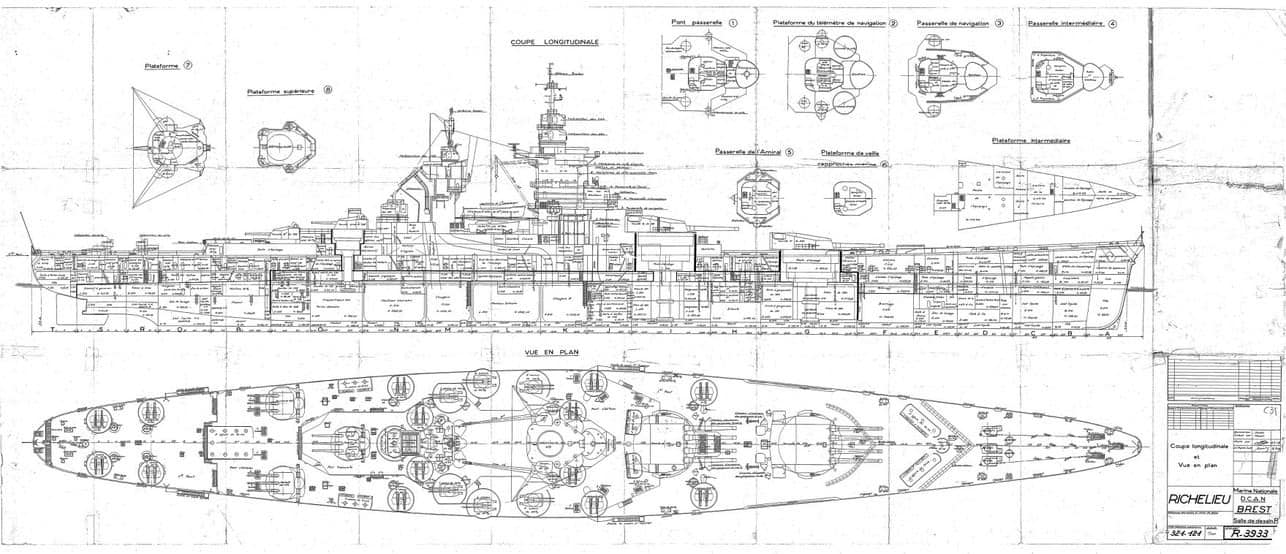
The Jean Bart being a sister-ship of Richelieu, she obeyed to the same basic design elaborated from 1936 onwards. Above: Richelieu as rebuilt in the US, 1944. There were several possibilities, one of which was to complete Jean Bart quickly to the same standard as Richelieu in the USN, 1944, with good AA and modern radar. That would probably included a trip to the US, and Richelieu in the meantime would have been deployed in the far east.
Given the work remaining compared to a scrapping, despite the cash-stripped context of post-war France, there was no debate about the question of completing her, but no consensus as to how the ship was to be finished. This debate however started right after France was liberated in the summer of 1944.

Tzoli attempted rendition of the conversion. secretprojects.co.uk more on the topic of the carrier conversion
One faction comprising Admiral Fenard, Pierre Barjot, Louis Kahn (Chief of Naval Construction, CNO), advocated the most radical approach, a conversion into an aircraft carrier. This had pros and cons. The idea was to provide quickly a modern (fast), large carrier, and compensate to the unbuilt Joffre class of 1939, or to the acquisition of foreign carriers, like Arromanches, a 1942 light fleet carrier, or Dixmude, an escort carrier. However at that stage, many saw the conversion of a battleship as a bad idea, pointing at the Béarn. At best it would have a sub-par air group for high maintenance costs and an armour not really needed for the purpose.
The second faction argued the ship should be completed as a battleship. But there were debates wether completing her the same way as Richelieu, or with an French upgraded AA, fire control systems and radars, a generation further.
A third faction suggested she ship should be scrapped, focusing on other, more modern projects. It had some strong support in the political class of the time.
In July, Admiral Kahn this prepared a proposal of a carrier conversion to feed the debate and try to win the cause. The one prepared has a capacity of forty aircraft plus fourteen spares, and was armed with sixteen 130 mm (5.1 in) AA guns, all in twin mounts, protected with an armored flight deck 90 mm thick, made of part of the dismantled armour frol the battleship. Displacement was setup at 40,000 t (39,000 long tons). The project was estimated to 5 billion francs, five years until completion. This estimation naturally cause a stir in the naval command, including Fenard himself, as it negated the advantage of a convesion in the first place. Cost and delays plus its limited air group were clearly a letdown compared to contemporary allied carriers. Even Arromanches with half the displacement carried a bit more. This buried the proposal for good.

The caracteristic Bridge of Jean Bart (forummarine.forumactif.com via pinterest)
As it was, Jean Bart left Casablanca on 25 August 1945 bound for Cherbourg, arriving after four days of quiet navigation. On 21 September, a meeting of the naval command ruled out scrapping the ship, and a serrious doubt was cast on the aircraft carrier conversion. The construction department made new estimates however for a completion as battleship, estimated the time to manufacture the missing 380 mm gun barrels, rebuild the missing “B” turret, stockpile ammunitions, and figures in the new French context of the time was four years until completion of the ship herself, one mire for the shells and charges. Decision to complete Jean Bart as Richelieu with improved anti-aircraft defenses, given the delays, seemed to get more traction. Naval historians John Jordan and Robert Dumas noted that even the “battleship faction” get support from the French naval air arm, opposed to a carrier conversion in the current conditions.
Jean Bart was towed to Brest, entered the dry-dock for hull repairs from 11 March 1946. The propulsion system was thoroughly examined, and completed as originally intended. Her main and secondary turrets were installed. The superstructure was modified, strenghtened for a future radar and fire control, that were planned to ba more extensive and modern than on Richelieu. The hull was completely modernized (many portholes were plate over, electric lighting had a rewiring) on 26 November 1947
Thus she could move from the drydock to the fitting-out berth, and further modifications brought to the superstructure, primary and secondary turrets, installed completely this time. She would return to the dry dock from 20 March to 9 October 1948 however for the installation of bulges and new propeller shafts. Initial propulsion machinery tests started on 4 December, and full tests by January 1949.
Redesign of the class

Hull and general design
The hull was pretty much unchanged compared to the previous Richelieu, apart the bulges added later to compensate for the added weight of the AA, radars and more extensive masts. The shape of the prow and bow were unchanged, just a few portholes were plated over, notably the lower prow serie. The changes were all made on the superstructures. Like Richelieu, her main and secondary artillery was unchanged, with the two main quad turrets forward, the three triple turrets aft. Although the latter left to be desired, not being able of dual purpose fire, there was no replacement for them at that stage, and they were just kept for practicity.
The most interesting aspect was their complete revision of the superstructure and AA armament on either side.
The conning tower was also kept, despite the concept being obsolete, also for practicity. The former lower bridge anchored around it was removed. Instead a single projector was anchored on a platform in front of it.
The main bridge structure was simplified, supporting a single two-storey bridge with portholes instead of a glassed bridge. The was no open bridge. The main director was of a new model, modernized version of the original, dispensing with the complicated three-tiered “turret” director arrangement of Richelieu. A second main director was installed on the “mack” aft. The mack combined funnel exhausts, directed aft, and a tower like platform for both the second artillery director and the aft mainmast. Both masts were not derrick but single piece style, but heavy duty to support heavier radars. The two frypan dish style fire direction radars were placed (see later) on either masts platforms in complement to the directors.
There were four service boats in the same previous space between the bridge and aft mack, served by boom cranes.
The sides were shaped in order to support the 24 (12 twin) main 100 mm AA guns in three-tiered positions, three facing forward and three aft. Four gunnery directors for them were installed abaft the bridge and mack. This was completed by 28 (fourteen twin) mounts wherever space was available, three on the upper superstructure, superfiring over the 100 mm, four aft on the poop deck, two on the upper bridge deck and two on the main forward deck.

Main dimensions were unchanged. The Jean Bart still measured 247.85 m (813 ft 2 in) overall for 33.08 m (108 ft 6 in) in beam. However displacement rose, and as a result, draft also rose to Full load: 10.9m (36 ft) instead of 9.9 m (32 ft 6 in) on Richelieu as built in 1940. However Richelieu rose to 10.68 m (35 ft) in 1945, for a Standard ported to 43,957 t (43,263 long tons) and 47,728 t fully loaded instead of 37,250/43,992 long tons. Jean Bart was noted depending on sources at 43,052 t (42,372 long tons) and 49,196 t (48,419 long tons) fully loaded, so she flirted with 50,000 tonnes. After all the losses of WW2, she was 10,000 tonnes shy of an Iowa class, or lighter than the 51,420 long tons Vanguard. It is assumed she was also much taller than Richelieu with her new masts. Overall, the added weight was recoignised by engineers which fitted new counterkeels and larger bulges in drydock in 1949.
Armour protection layout

Jean Bart in 1949, note her US graded camouflage. src navypedia.
The armour was unchanged compared to the original. In short, Jean Bart kept the same armoured Belt, 330 mm (13 in) thick running between barbettes and defining the citadel. The main deck, closing the top of the citadel, was 170 mm (6.7 in) string with sloped ends on both sides. The main deck was down to 150mm beyond the citadel, and the lower deck was 40 mm thick with 50 mm slopes. The torpedo bulkheads were 30 to 50mm thick fore and aft. Turrets were protected for the frontal part of 430 mm (17 in), 170 mm to the back and roof, Barbettes were 405 mm. Secondary turrets ranged from 70 mm back and roof to 115 mm faces and sides, frontal arc. The Conning tower was 340 mm (13 in) thick as well. ASW compartimentation was at the best standards of the day, with internal bulges, longitudinal bulkheads, deformation zones and void compartments to buffer any torpedo hit. Puumps could be used also to compensate any list.
Powerplant
This part is also little changed compared to the original. Jean Bart had the same two pairs of propeller shafts, outer and inner, driven in turn by widely spaced Parsons geared turbines and fed in turn by six Indret Sural boilers. All were widely separated in their own compartments for anti-flood measures and redundancy. This produced in total 155,000 shp (116,000 kW). In addition the ship was equipped with two diesel generators to feed the electronics and AA armament when “cold”.
Top speed was 32 knots (59 km/h; 37 mph), always and argument in any bad encounter, and Range was 9,500 nautical miles (17,600 km; 10,900 mi) at 15 kn (28 km/h; 17 mph). Less than US or British standards, but the Richelieu class was originally designed for mid-Atlantic operations and the Mediterranean.
Armament
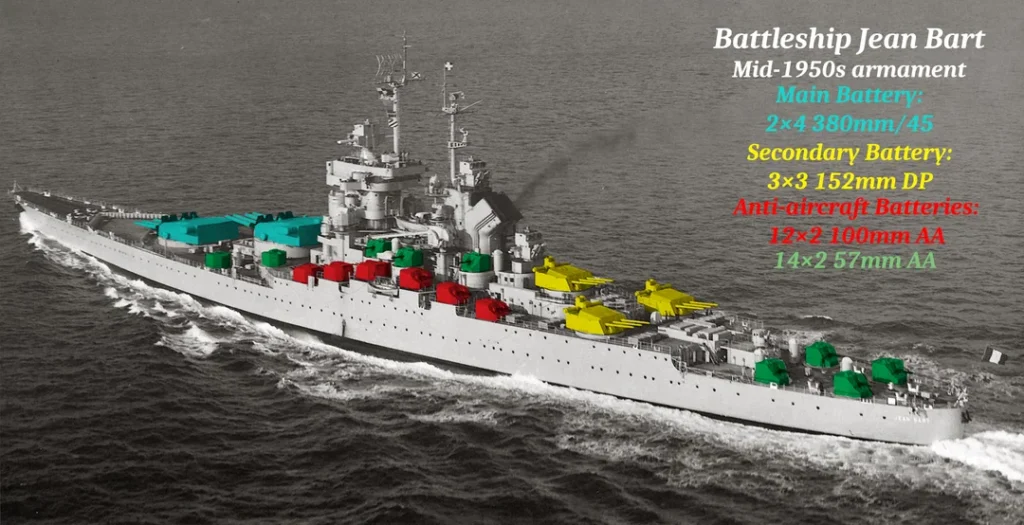
The Jean Bart artillery in a nutshell. Src warshipporn, reddit
Main: 2×4 380mm
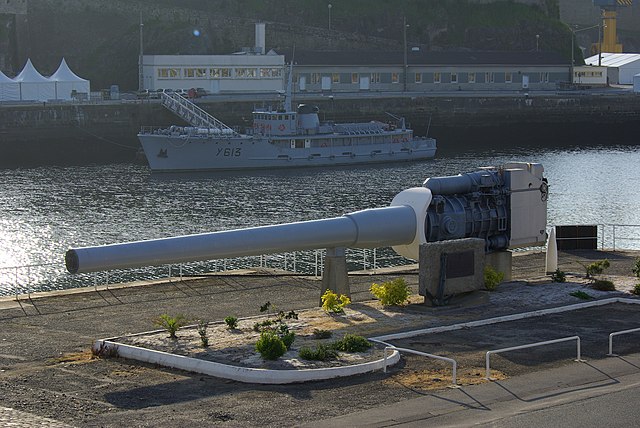
One of Richelieu’s guns in Brest.
Eight (Two quad turrets) 380 mm (15-inch)/45 Modèle 1935 guns: These in 1950 were still an argument. Gunfire was used in shore operations in Korea, Suez, Vietnam and the Gulf war as well. The “classic” French recipe of all guns forward came from an idea expressed shortly after WW1 after “barring the T” tactics and the advantages of a forward artillery in several configurations of naval combat, but also the rationale of a restricted immune zone compared to a classic configuration with turrets fore and aft – Washington treaty obliges -. This was an elegant, albeit unusual and radical solution to the eternal issue of tonnage restrictions. Still the Richelieu were far better protected than the Dunkerque, Scharnhorst, and some argues, Littorio or Bismarck.
The two quad turrets were designed however with a catch. The two pairs of each turret were separared by a bulkhead inside the turret. The idea one fatal hit on the turret could only disable one of the pairs. This way, these quad turrets were designed like paired twins with a lot of redundancy.
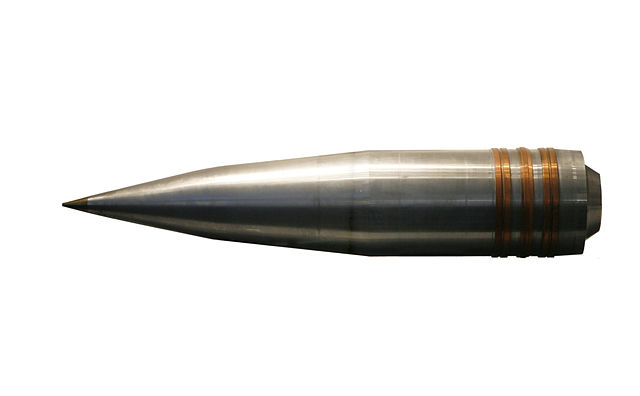
The sides of the turrets sported two small guns each. They were saluting guns. Each turret had its own backup telemeters in case the main ones were disabled.
The modernized fire control system and radars allowed far more accuracy in naval bombardments compared to Richelieu anyway.
These guns used Welin breech block, were hydro-pneumatically powered with a 132.5 cm (4 ft 4 in) recoil. They could elevate to 6°/s with a 300° at 5°/s; and they had a rate of fire of 1.8 /min per gun, with a muzzle velocity of 830 m/s (2,700 ft/s) 41,700 m (45,600 yd) range at 35° elevation, with streamlined shells, HE or AP.
Jean Bart used the same shells as Richelieu (the lates ones were made in USA). The outfit for Jean Bart as completed in 1950 comprised the following: 368 APC and 386 HE.
By 1957, this changed to 328 APC and 406 HE according to her bombardment role, as well as 3,000 quarter charges.
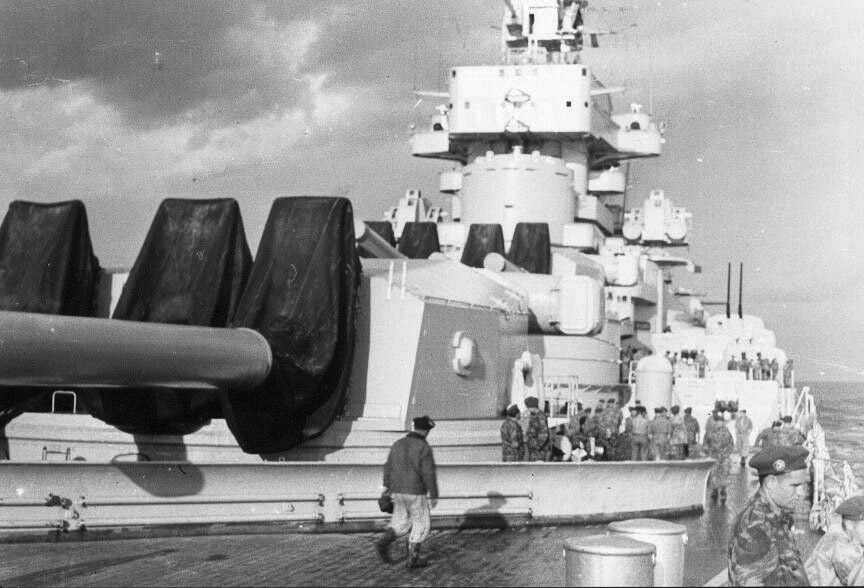
Jean Bart’s main guns
3×3 130mm DP
Jean Bart sported three triple turrets, so the equivalent of a light cruiser, with nine Canon de 152 mm Modèle 1930. They were designed originally as single purpose on cruisers, but were modified as dual-purpose in new turrets designed specifically for the Richelieu class. The turrets had cutouts enabling an angle almost up to 90° and the mounts were modified for high angle fire accordingly.
They however in practice were quite limited. In theory they could fire up to 85°, but this was reduced to 45° for practical reasons. Decent in naval gunfire, they were ill-suited to engage AA targets as most heavy dual purpose guns of that generation: It was planned to load at any angle, but this was limited +45°. They were slow to train and elevate and had a slow rate of fire. They only could have been use in “deliberate fire” on an incoming formation, but not engage at closer ranges. In this case, the secondary AA was taking over.
12×2 100mm DP
These were the same as the ones essentially carried by the contemporary AA cruisers of the French Navy (De Grasse and Colbert) as well as the T47 and T53 destroyers.
These twin M1948 5-in or 127mm/54 were placed in in tiered superfiring positions on either flank. This configuration enabled the best lateral arc of fire as well as still six guns in chase and retreat. They could not cover each others, being separated by the massive bridge and mack.
The Model 1948, was a 54 caliber gun made fully compatible with USN and NATO standard 5-in/38 ammunition. They recalled thos of the Sumner/Gearing but they were noticeably smaller, more compact. They had been designed as heavy dual purpose weapons, first high-angle mountings, and development of 1940 twin 130mm mountings. Not automated, they needed each a crew of 11 to operate, and thus were criticized for being over complex and failing to meet requirements in rate of fire: 12-13rpm in practice.
They fired the AAC Mark 41, HC Mark 41, Illum. Mark 48, HE Com Mark 42 or VT Mark 41 rounds averaging 69 Ibs (31 kgs) at 2,650 fps (808 mps), at 24,060 yards (22,000 m) or AA Ceiling (85°) of 29,530 feet (9,000 m).
More on navweaps.
14×2 57mm AA
Second standard postwar French AA mount, these were essentially scaled-up variants of the Bofors, used also by the Netherlands and Sweden. Bofors proposed it in 1948. France adopted the 57 mm/60 (2.25″) Model 1951, and still needed loaders dropping individual rounds into ammunition boxes instead of clips, but they could fire at all angles. Their “shelf life” was short with rapid jet development, despite a rather good rate of fire of 120 rounds per minute cyclic, at 45° to 15,860 yards (13,000 m) in range and 18,040 feet (5,500 m) ceiling. More on navweaps.
More surprisingly, the 1950 Jean Bart still sported thirteen 20-mm/70 Oerlikon single Mark 1.2 light AA guns: Two on either of the “B” main turret nacelles, and four in the “square” aft of the triple secondaries. Pas 1956 they were removed and the spaces aft used for extra bins.
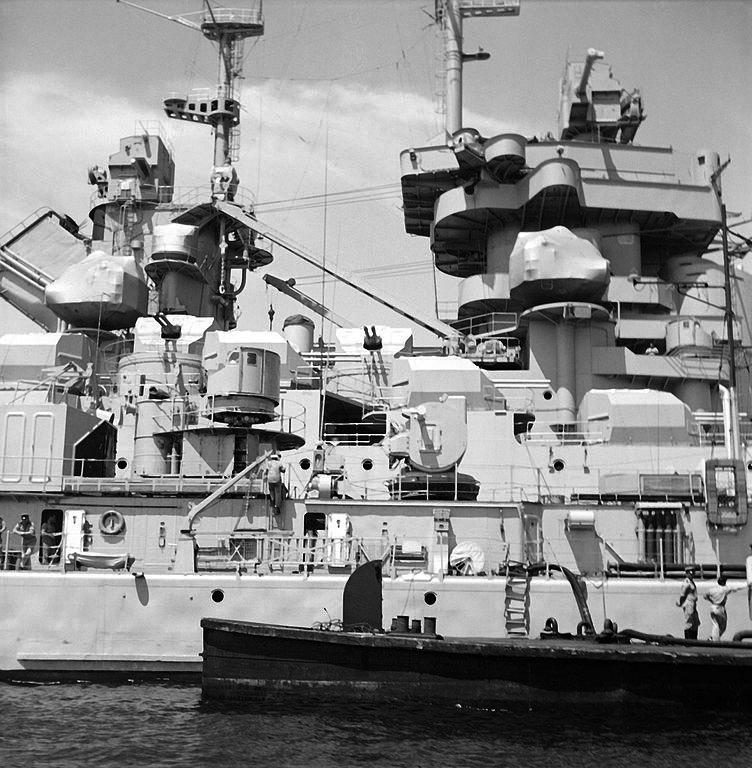
Closeup of the Bridge while in Toulon, showing the secondary fire control systems
Sensors
DRBV 11 air/surface search radar
DRBV 20 air search radar
DRBV 30 navigation radar
DRBC 10A fire control (FC) radar
Six ACAE FC radar
Five DRBC 30B FC radar

Author’s profile of FS Jean Bart as completed in 1955
⚙ Jean Bart 1949 specifications |
|
| Displacement | 42,806 tons standard, 49,850 tons fully loaded |
| Dimensions | (242pp) 247.9m oa x 35.4m* x 9.22-9.90 m mean draft |
| Propulsion | 4 shafts Parsons geared steam turbines, 6 Sural-Indret boilers, 16,200 shp |
| Speed | 32 knots (59 km/h; 37 mph) |
| Range | 5,850 nm at 18 kts, 9,500 nm (17,600 km; 10,900 mi) at 15 kn |
| Armament | 2×4 380mm/45 M1935, 3×3 152mm/55 M1936, 12×2 100mm/55 M1945, 14×2 57mm/60 M1951, 20x 20mm/70 Mk 4 |
| Protection | Main belt 330mm, deck 150-170mm, Turrets 170-430mm, CT 340mm |
| Crew | 1,569 |
*After adding extra bulges, originally 33 meters (108 ft).


See the version colorized. She was in Toulon, pending scrapping.


Netmarine.net via pinterest. Toulon, late career. Colorized
Early Career of Jean Bart (until 1945)
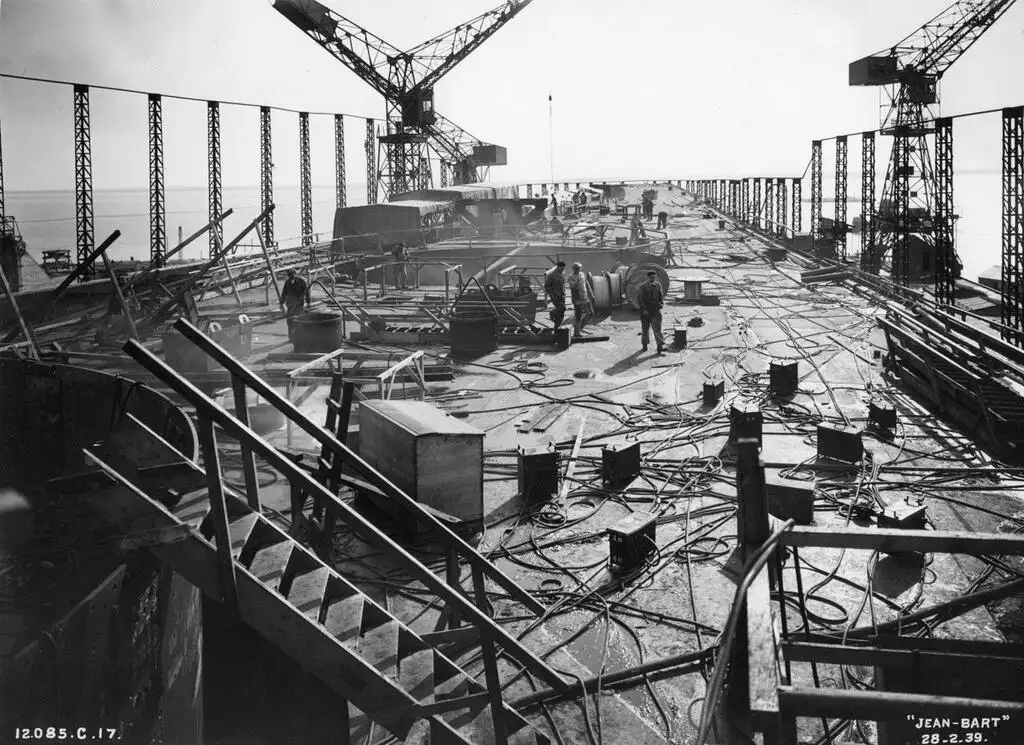
Jean Bart in construction. Credits: coll. saint-nazaire écomusée, chantiers de l’atlantique. src
Jean Bart was ordered on 27 May 1936 from Chantiers de Penhoët shipyard in Saint-Nazaire, and sub-contracted to the nearby A. C. Loire shipyard as the former was still busy with the previous Strasbourg. The keel was laid down on 12 December 1936 and her construction created a violation of the treaty due to the tonnage limit of 70,000 long tons (71,000 t) for battleships being surpassed before the expiration of the moratorium. The two Richelieus and two Dunkerque indeed reached together 123,000 long tons. But France used the unilateral Anglo-German Naval Agreement which nullify Germany’s being bound by the Treaty of Versailles in June 1935. Serious work had to wait for dockyard workers and completing Strasbourg so she layed in Caquot dock (now “Jean Bart dock”) with work proceeing slowly at least until tensions with Germany by early 1939 flared up. The invasion Poland put a premium for completing her.
A delayed construction (1937-39)
She was launched on 6 March 1940, and by May, it was realized that fitting-out was not possible given recent developments, these fears soon became fully justified. Instead, it was decided to prepare her for a fitting out in another, safe port, and to sail at the latest notice with everything needed aboard. Work focused then on completing the propulsion system above all else, with 3,500 workers in three shifts, working around the clock to install three of her boilers, two sets of turbines, two turbo generators, two pumps and the most important internal communications systems.
The outer shaft propellers were installed on 6 and 7 June, while the three aft boilers were fire-tested for the first time on 12-14 June. Rudder and anchor chains were installed while her double bottom was completely sealed in order to depart as soon as possible. Her armament very partial. She only received her forward main battery turret, complete with guns and plating. However “B” turret only had cradles installed, no guns, not roof. The shell handling equipment was absent, as the fire control systems as the secondary turrets, with the turret rings provisionally plated over. At the last minute in case the Luftwaffe would attack her underway, it was decided to install several twin-mount 90 mm (3.5 in) Mle 1930 anti-aircraft guns. They stripped the netlayer Gladiateur and were craned down and fitted on 18 June, in place of the intended 100 mm twin guns. But no ammunition was provided, nor director. Three 37 mm guns, six of 13.2 mm mounts were also installed, under partial control of the incomplete main director.
A daring Escape
Her appointed commander, Capitaine de vaisseau Pierre-Jean Ronarc’h (previous captain of Strasbourg) was ordered on 11 June to depart for Casablanca, Morocco (French protectorate) so as soon as practical. The Germans already achieved in May their rush to the north sea at Dunkirk, but the progression southwards took more time hopefully. He setup the date of 19 June based on the local tides. With all the necessary basic crew to man the ship being summairly train, this morning, Jean Bart was towed out of the fitting-out dock by three tugboats. At 03:30 she entered the channel, rushed-dredged but still she grounded in the darkness, even bending one screw blade, but the tugs managed to pull her free.
At 04:45 her engines were started for good, and as she proceeded to slow speed, she was at noon flew over by three German Heinkel 111 bombers, going down for identification at 1,000 m (3,300 ft) and then to attack the ship whe they realized what happened.
One He 111 armed with bmbs managed a hit, the 100 kg (220 lb) bomb striking the deck between the main battery turret, but damage was light. Captain Ronarc’h then order 12 knots (22 km/h; 14 mph). At 06:30 at last she met the expected destroyers Le Hardi and Mameluk sent to add their fuly working AA defence and guard her to Casablanca.
In an event that prefigurated Catapult, the British destroyer HMS Vanquisher came to meet her with two tugs as she proceeded down the channel. By signals, Vanquisher’s captain offered to tow Jean Bart to Britain. But Ronarc’h, under strict orders to proceed to Casablanca, declined the offer. Later underway, the battleship was refuelled by tankers and at 18:00, left behind the two destroyers off Lorient, later joined by the destroyer Épée instead of Le Hardi and they proceeded at 24 knots (44 km/h; 28 mph) in the Bay of Biscay (now out of range of the Luftwaffe), rounding up the Spanish coast until Gibraltar. They arrived in Casablanca at 17:00 on 22 June.
Purgatory in Casablanca
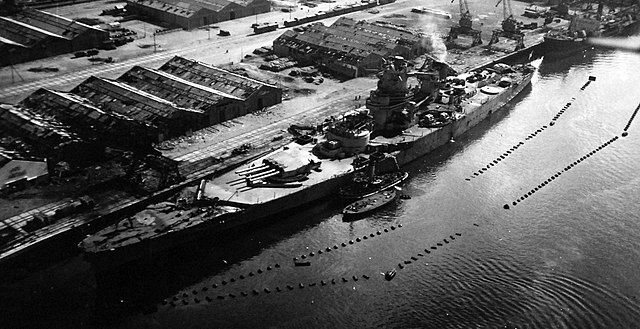
In Casablanca, Jean Bart saw her onboard anti-aircraft guns removed and relocated around the port to bolster its defenses. The 90 mm and 37 mm guns ended on the jetties protecting and some of the 13.2 mm guns were put on trucks to bring a mobile defence. The Armistice of 22 June 1940 was signed. Negotiations led to the neutralization of Jean Bart and other ships in Oran (Algeria) but the final agreement stated both Jean Bart and Richelieu were to be sent in Toulon in Vichy occupied zone, to be demobilized. The Germans later cancelled this, fearing the British would try to seize the ship while underway in the Strait of Gibraltar. On their size, it’s the fear of their seizure that worried PM Winston Churchill above all else, leading to Operation Catapult in July.
By the time, no work had been done on Jean Bart, was now subject to possible British attacks. Ronarc’h started to take measure to protect the battleship, opening barbettes for the secondary turrets, having the superfiring turret covered with concrete and complete sealing og he hull, which was moved the in shallow water on 11 August in case she was to sink. 11 days later Ronarc’h was replaced by Captain Émile Barthes. In September, work proceeded as much as possible to have the ship combat ready. Casablanca however offered little in terms of supplies, materials, or cranes. On 7 September, sixteen 13.2 mm guns, seventeen 8 mm (0.31 in) machine guns were installed, judged better than nothing. In 1941, Jean Bart received an improvised director, made by using a using a torpedo tube platform from the old Enseigne Gabolde, to support a 14 m (46 ft) rangefinder. There was also a 3 m (9.8 ft) rangefinder installed on the conning tower, two more were added on the bridge wings by October to command the AA.
April 1942 saw the addition of a beefed up anti-aircraft battery: Four 37 mm guns, all in single mounts and at last, two twin 90 mm guns. In May 1942, the forward (A) main battery turret was declared operational. On 19 May, Jean Bart conducted test firing but her improvized director did not helped. Thus a land-based triangulation system was improvized with observers seated at Dar Bouazza and Sidi Abderrahman, passing information to the ship’s command. Four 37 mm guns (twi twin mounts) also were installed in June, and two 90 mm twins, and then three 37 mm singles removed. A french-designed DEM radar was also installed, tested to detect aircraft at up to 70 km (43 mi) hampered by the clutter of the harbor. It was thus impossible to detect surface ships. The radar operator was declared operational by 6 October. November, saw the addition of a fifth 90 mm twin mount, a sixth planned when Operation Torch was launched. The ship by then had five 90 mm twin mounts, five 37 mm guns (in twins and single mounts), eighteen 13.2 mm guns (two twin, fourteen single) and a single 8 mm Darne LMG.
The Battle of Casablanca
Allied forces launched Operation Torch on 8 November. On Casblanca sector, the US fleet counted the recent battleship USS Massachusetts , aircraft carriers USS Ranger and USS Suwanee, and three heavy cruisers. On the US side, a Free French infiltration operation was ongoing, tracts were sent, and the US command expected a quick surrender and if possible no fighting at all. A French reconnaissance aircraft spotting this morning the fleet at 07:00 and reported it to the local forces.
In Casablanca Vichy Forces under Felix Micheler aligned a single light cruiser, nine destroyers, several submarines, and the coastal battery at El Hank. Of course there was also the single quad turret of Jean Bart, now a floating battery in all effects. Massachusetts and two cruisers however soon received a clear picture of the harbour thanks to recce flights and started bombarding the port. Meanwhile, Ranger launched its SBD Dauntless dive bombers flights, all armed with 500 lb (230 kg) bombs to start sinking targets of opportunity, chief of which was Jean Bart and the cruiser Primauguet. Jean Bart received a two hits right away at 07:18, destroyer her port catapult, and flooding in the steering compartment and the other hit the berth close to her hull, which saw heavy buckling of many plates, starboard side.
Jean Bart then opened fire in turn at 07:08 and 07:19, with four salvoes whereas the French cruiser tried to lead the destroyers into a desperate sortie, laying a smoke screen. Massachusetts, guided by a spotter, started to engage Jean Bart. At 07:25 a 16-in hit went through two armor decks, exploded in empty magazines of the 6-in guns. Another salvo straddled her bow at 07:35. Then on hit on the quay showered her with fragments injured the AA gunners. At 07:37 one shell went through the funnel and ended on the edge of the armor deck another hit the quay and projected fragments in her outer plating close to the armor belt, and was buried in the sea floor. At 08:06 Jean Bart took two more hits: One hit the main battery turret, deformed the front glacis, jamming it. The second hit the superfiring barbette, with fragments performing the armor deck. One hit at 08:10 on the quarterdeck, exploded below the armour deck into the ballast compartment, and acceelerating flooding in the steering compartment. Still Jean Bart’s main battery remained operational. Workers cut away the deformed steel and freed the forward turret free.
By that time it was 17:24. The entire French fleet had been gutted: The cruiser and destroyers were “greeted” by two cruisers, destroyers and further air attacks, and in all, four destroyers and 7 submarines had been sunk, one scuttled, two more damaged, one destroyer and two flotilla leaders grounded as a submarine. The sole squadron defending the area had been eliminated. US troops in between had been landed and quicky rounded up defenders.
The 9 November, on Jean Bart, still in French hands, 90 mm guns started to open up on advancing ground troops in the harbour. On 10 November Jean Bart, assumed out of action, started firing on the heavy cruiser USS Augusta at 11:41 and 11:51, and at the second salvo, straddle her, then more coming, forcing her to withdraw at high speed. USS Ranger prompted an air strike of nine Dauntlesses equipped with “battleship-busting” AP 1,000 lb (450 kg) bombs, protected by eight F4F Wildcat. They arrived above Jean Bart at 15:00 and while the Wildcats strafed AA batteries, the Dauntless took their formation column at higher altitude, ready to dive in turn. Two scored hits right away, gutting the forecastle and toward the stern with serious fires only dealt with by 20:00. Flooding was such that the battleship started to settle by the stern, and lost her turbo generator and main diesel generators. Now only the power of the backup diesels could provide some remaining energy. 22 were killed, 22 wounded since the 9th. 25 shells had been spent, many more were left with both the main battery and 90 mm guns still operational, but no power.
Under Free French Control
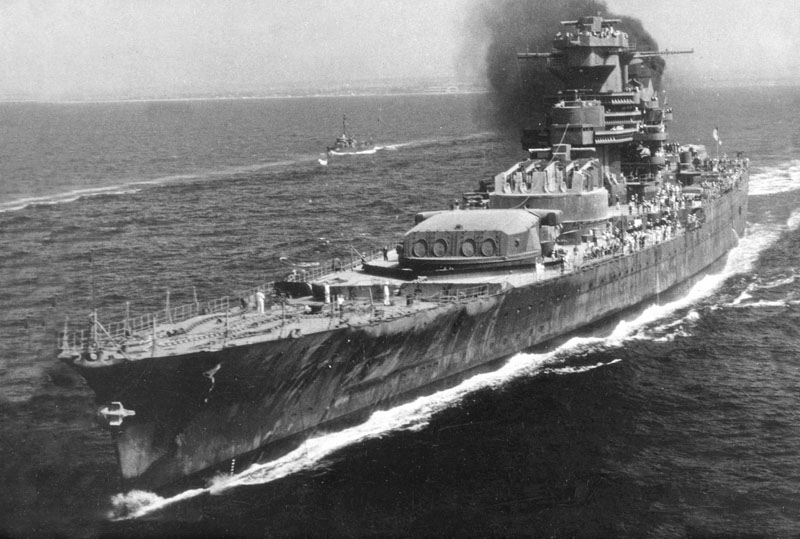
Back to Cherbourg in 1945
The armistice on 11 November caused a ceasefire in North Africa. Meanwhile back in France, the Germans launched Operation Lila to try seizing the French fleet in Toulon, but failed as the latter scuttled itself as Darlan promised to the allies. On the same day, Jean Bart was already repaired, now on behalf of new authorities and by 15 February 1943, she had her turbines and steering controls operational. At that stage, it was Admiral Raymond Fenard (the one which later envisioned a conversion as aircraft carrier for Jean Bart) took the head of a naval mission to the US to persuade the Navy to have her towed and repaired, then completed as Richelieu. The report went to Vice CNO Admiral Frederick J. Horne on 15 April but five days later of the US agreed it was possible to tow the ship in the US by September, but repairs to the steering were needed prior.
The Free French Service Central des Constructions et Armes Navales then studied two proposals of completion, and both argued the replacement of the 380 mm guns by the 340 mm (13 in) from the battleship Lorraine while Jean Bart’s guns replaced those on Richelieu. One proposal included a quarterdeck modified with two large catapults and six TBF Avenger or British Fairey Barracuda, F6F Hellcat, Seafire as a “semi-carrier” or hybrid battleship. Thirty 5 in (130 mm)/38 (fifteen twin) were to be installed and sixty-four Bofors 40 mm (1.6 in) in quadr mounts, fifty 20 mm (0.79 in) in single, new fire control (US directors, Mk 4 fire control radar). It was eventually dismissed as too ambitious and long to setup. The second “austere” proposal saw the initial catapults and aviation abandoned, the space used for extra twin 5-in turrets and twenty quadruple 40 mm Bofors.
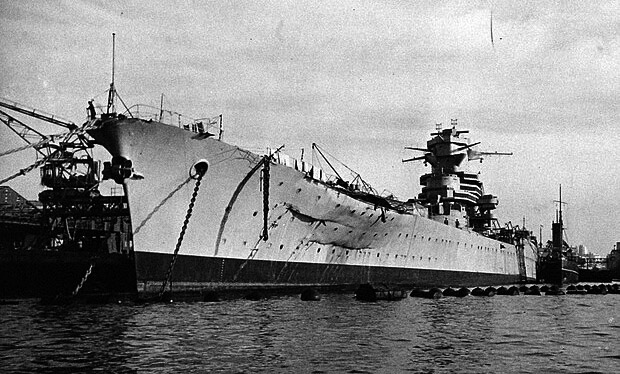
Damage repair in Casablanca complete, 1944
However VADM F.J.Horne rejected both proposals on 18 August. Fenard then proposed to convert the ship as aircraft carrier, also refused. On 8 December, Fenard contact directly CNO Admiral Ernest King but his was dismissed by March 1944. The USN by that stage did not lacked asset. Available yards were needed to repairs US and British ships in priority. And the experience with Richelieu led to doubts abot reproducing parts necessary for her sister ship. Only Richelieu, far more complete and with significant British pressure obtained this upgrade. Meanwhile Jean Bart stayed in Casablanca, repaired and prepared to set sail for home, hoping to complete her in a French yard later. Only Brest was suitable, but it had to wait until September 1944 to be freed. Some thought of the Gibraltar shipyard, but it was already busy for months. The battleship nevertheless was repaired and made ready for sea trials by September 1943 with the DDs Basque, Le Fortuné and three US destroyers in case of an axis air attack. She managed 22.5 knots but the alack of resources meant she became a training ship at Casablanca.
By early 1945, postwar fleet plans were made already.
Without consensus on her completion, Jean Bart left Casablanca on 25 August for Cherbourg, ended in Brest dry-docked, fully repaired from 11 March 1946 and completed until 26 November 1947, followed by fitting-out and changed made in her superstructure, AA guns and radar masts (see above). Full tests started in January 1949, gunnery tests, and by May 1949 she at last received her assignation, in the “Groupe des bâtiments de ligne” (“Battleship Group”) with her sister Richelieu, until 1950.
Jean Bart after reconstruction: 1949-1970
A long completion
Jean Bart started her new cold war career with fleet training exercises off North Africa by May-June 1950. She received post-fixes in Brest, and by early 1951 was back to Mediterranean training. In Le Havre she had a degaussing system installed and tests of fuel consumption. By 7 July she was back in Brest to have her main and secondary batteries fully operational but she still lacked at that stage her intended anti-aircraft battery, fire control and radarst. November 1951 was the start of her final upgrade. She would receive all her intended AA turret while her secondaries were modified for truly effective dual-purpose fire, fire control and new radars added. But it took time, 1952, then 1953 for the first gunnery tests in July that year and more modifications until she was truly complete and operational by October 1954, still waiting for her 57 mm guns, tested by September 1955, and optical directors fitted by August 1956. In her final state she had upgraded radars, the DRBV 11 air/surface, DRBV 20 air search, DRBV 30 navigational. Fire control radars were the DRBC 10A (main) and six ACAE sets for the medium AA and five DRBC 30B (Light AA). In this final state, however the world had moved on. The 50,000 tonnes battleship, more capable and impressive than her sister, was already nearing obsolescence due to the arrival of very capable jets. In both the US and Soviet Union or Britain, missiles were tested and looked like the future.
Showing the flag
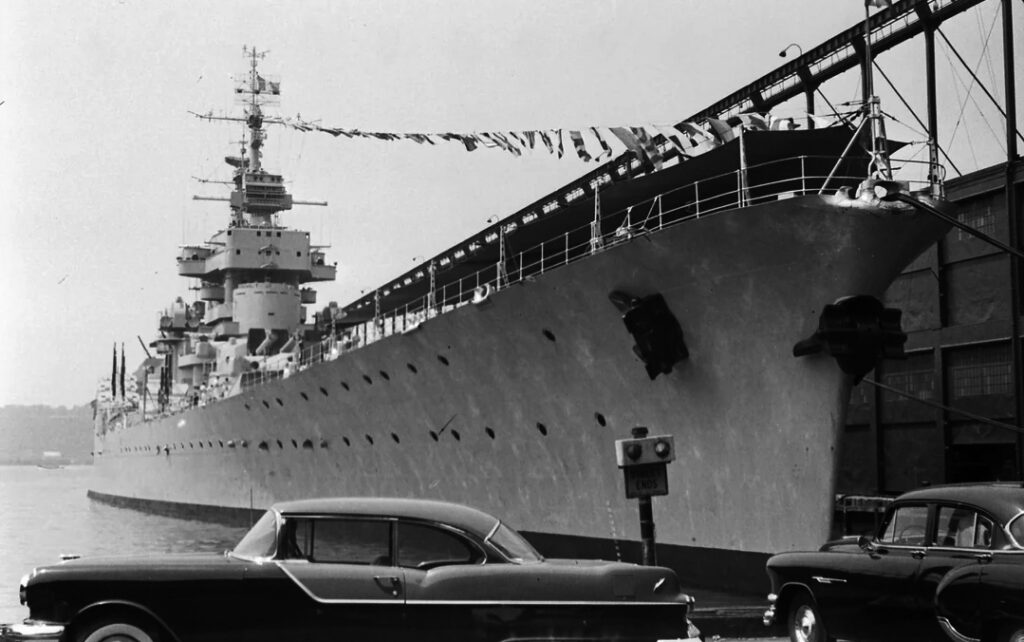
Jean Bart in New York, 1955
With Jean Bart “officially” complete on 1 May 1955, she was now more an object of national pride and symbol of French renaissance than a practical asset for the fleet. A bit like Vanguard, she was now a bit of “show boat”. President René Coty took a trip to Denmark on this battleship, escorted by the destroyer Surcouf, then Oslo, and culminating with a celebration in New York for the 175th anniversary Comte de Rochambeau landings and the American Revolutionary War. No doubt he US staff looked at her impressive AA battery with interest. Next Jean Bart multiplied training cruises off Brittany and the winter saw her transferred in the sunny Mediterranean, Toulon on 17 October, and succeeding to Richelieu as flagship.
In 1956 she stayed in Toulon, venturing for gunnery training at Hyères range, and just for the photos, Richelieu and Jean Bart cruised together, on 30 January 1956. June saw Jean Bart éshowing the flag” in North Africa. Her first true combat action was just around the corner: The Suez crisis. On 8 July she would lead the French squadron off Egypt. Jean Bart had her superfiring turret reactivated in August. On 7 September escorted by Georges Leygues she made some gunnery practice.
The Suez Crisis
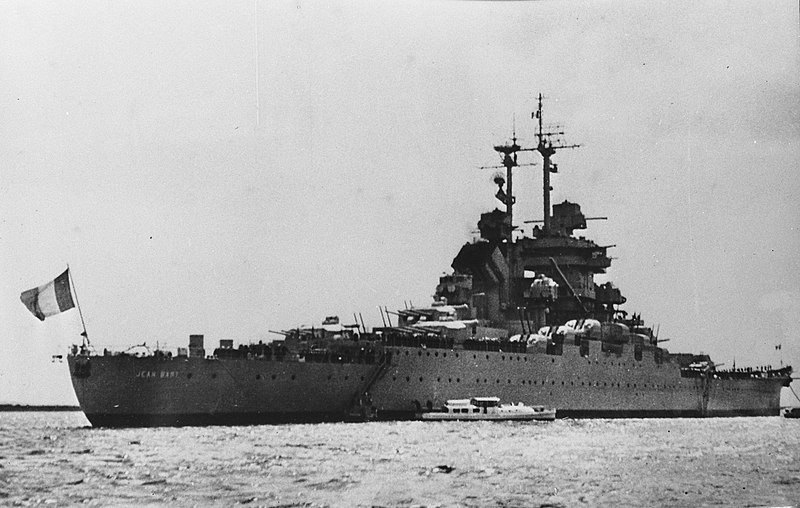
Jean Bart in the Suez Canal
She was deployed with the Intervention Force in what was called “Operation Musketeer/Mousquetaire” with a crew of 1,280 officers and men (2,200 if fully complete, way more than Richelieu). She only had 50% of her anti-aircraft guns manned and her superfiring turret operational. She left Toulon on 26 October to Algiers, embarked the 1st Foreign Parachute Regiment, and Commando Hubert frogmen unit then joined the rest of the fleet: The carriers Arromanches and La Fayette, modernized cruiser Georges Leygues, T47 destroyers Surcouf, Kersaint, Cassard, Bouvet, plus the ASW group. They haled in November at Limassol in Cyprus and proceeded to Egypt to launch the paratroopers and frogmen, swapping on amphibious assault ships. On 5 November, Jean Bart took position to shell Port Said, but only fired once before the landing was cancelled as the airborne operation took all objectives. She remained until the 7th and went back to Toulon as the crisis was resolved by US-Soviet arms twisting.
On 1 December, Jean Bart resumed her training scheduled by July 1957, with her last main battery gunnery practice, and by August, she was placed in reserve but government’s pressure, much to the dismay of the naval staff after the time and cost to complete her. Crew shortages were a reason, since many new ships had been completed in between. A report also lambasted the maintenance costs of the battleship in the parliament. It was plan to withdraw her from active service in 1959 (like Richelieu). Modernization proposals to keep her relevant were put forward, including a hybrid conversion as guided missile battleship as it was done in the US with USS Mississippi.
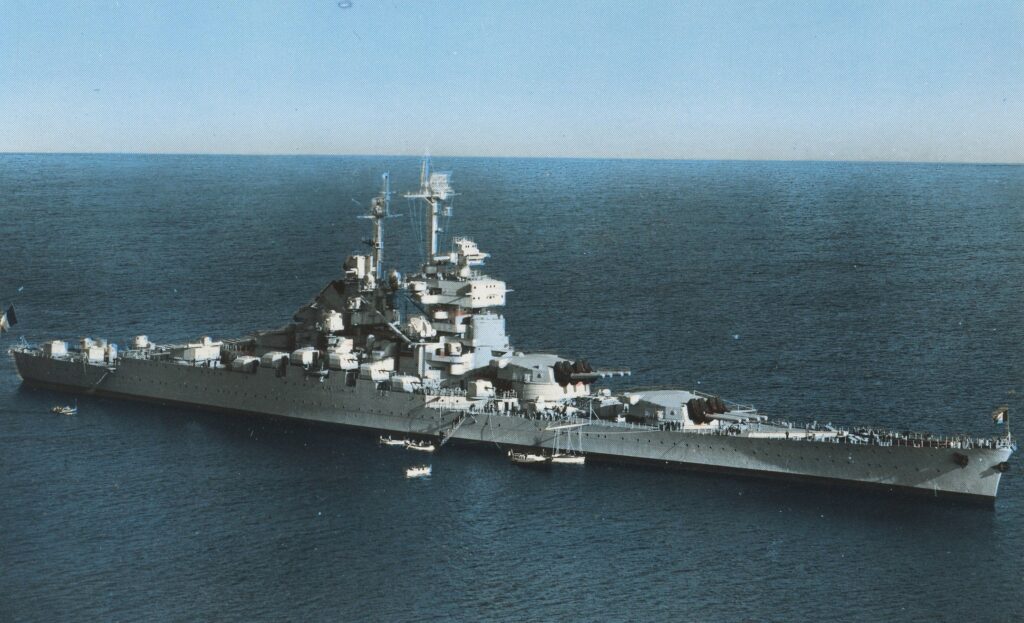
One proposal combined two Masurca missile launchers with 44 missiles one her quarterdeck, main turrets replaced by a large missile battery in an early form of VLS, for 325 missiles. Other proposed a more auster conversion with an American RIM-2 Terrier missile installed aft instead of the 152 mm turrets for evaluation.
But again, the cost and delays of these proposals were seen as a wast of public spendings. Even the high command was dubious about the first proposal. By August 1957, Jean Bart, still in reserve, was now already used as barracks ship with a nucleus crew. From 1 January 1961 she went into a deeper reserve status, permanently moored and with minimal inspection. By 1964 some proposed to have her reactivated and modified as command to overview nuclear experiments in the Pacific. Instead the cheaper option of converting De Grasse was chosen. Jean Bart remained laid up until 10 February 1970. By that time, the wheel turned full circle and the batteship era seems gone for ever. Richelieu, Vanguard were gone, and even the four Iowas, out of reserve for shore bombardments missions in Vietnam, were now back to reserve without prospects of reactivation. Jean Bart was stricken and renamed Q466, and put in the sales list. On 21 May, she was towed to Brégaillon where a breaker start work, and she was completely broken up circa 1945.
So in the end, what was Jean Bart: A waste of time and money ? Her very long completion time, caused by numerous delays with her AA and fire controls, had her pushed back from 1949 to 1957. Apart her very shoprt figuration at Suez,she had missed Indochina, and was of no use in French Algeria, as the war raged well inland. The naval staff was now complating missiles, not big guns, with more efforts put into two unfinished WW2 cruisers, De Grasse and Colbert, a new generation of destroyers, of submarines, and with the return of De Gaulle in 1958, France was now steering vigororously towards a full deterrence program that would eat most of the budget allocated to the Navy. Far less useful in 1958 than France’s two brand new carriers, the Clemenceau class, she was condemned.
Her true active service was thus very short, since between her official completion in 1955 to her reserve in 1957, only two years had passed to justify in the eyes of French taxpayers, an enormous cost of completion and reconstruction started already in 1945. Still, in the eyes of the admiralty, she was not a total waste of money, as she pioneered as test bed new French anti-aircraft guns and associated radars. She was completed a bit earlier than De Grasse and Colbert which underwent similar transformations and her weapons systems were also seen on a whole serie of destroyers (the T47 and T53). The ships that really “killed” Jean Bart were actually two large missile destroyers, the 1963 Suffren class. They really look sleek and modern, and their capabilities against modern jets were not in doubt. Some could argue Jean Bart could have been used both as training ship and ambassador, but between her massive maintenance costs and huge crew, that proposal could not receive any favourable outcome from the parliament. More so, De Gaulle publicly condemned her as belonging to the “pages of history”. She could only be an hinderance to his precious deterrence program.
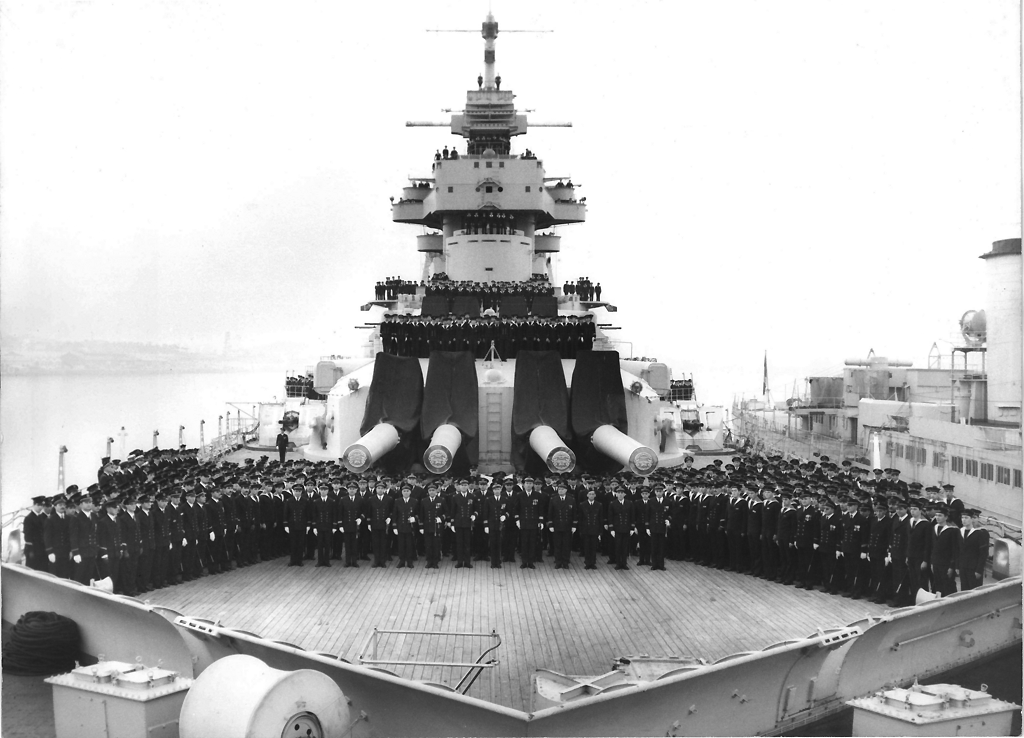
One of the last photo of FS Jean Bart with the full crew, Toulon, 1960.
sources
Books
Georges Blond, L’épopée silencieuse, dernier chapitre, Éd. Grasset 1942 1970.
Pierre-Jean Ronarc’h, L’Évasion du Jean Bart, juin 1940, éditions Flammarion, 1951
(en) H. T. Lenton, Navies of the Second World War German surface vessels 1, Londres, Macdonald&Co Publishers Ltd, 1966
Adolphe-Auguste Lepotier, Les Derniers Cuirassés, Paris, Editions France-Empire, 1967
(en) H.T. Lenton, Navies of the Second World War American battleships, carriers and cruisers. Macdonald&Co Publishers Ltd, 1968
(en) Henri Le Masson, Navies of the Second World War The French Navy Volume 1, Londres, Macdonald&Co Publishers Ltd, 1969
Donald G.F.W. MacIntyre et Basil W. Bathe, Les Navires de combat à travers les âges, Paris, Stock, 1971
(en) H. T. Lenton, Navies of the Second World War British battleships and aircraft carriers, Londres, Macdonald&Co Publishers Ltd, 1972
(en) Siegfried Breyer, Battleships and battle cruisers 1905-1970, Macdonald and Jane’s, 1973
(it) Giorgio Giorgerini et Antonio Nani, Le Navi di Linea Italiane 1861-1969, Ufficio Storico della Marina Militare, 1973
(en) Jean Labayle-Couhat, French Warships of World War I, Londres, Ian Allan Ltd, 1974
Philippe Masson, Histoire de la Marine Tome 2 De la vapeur à l’atome, Paris-Limoges, Charles Lavauzelle, 1983, 582 p.
Robert Dumas, Les cuirassés « Dunkerque » et « Strasbourg », Rennes, Marine Éditions, 2001, 125 p.
Robert Dumas, Le cuirassé « Jean Bart » 1939-1970, Rennes, Marine Éditions, 2001, 125 p.
Robert Dumas & Jean Guiglini, Les Cuirassés de 23 500 t [archive], éditions de la Presse, 2005.
Bernard Prézelin, Flottes de combat : 2008, Rennes, Éditions Maritimes et d’Outre-Mer, 2008
(en) John Jordan et Robert Dumas, French battleships 1922-1956, Seaforth Punblishing, 17 septembre 2009
Links
navweaps.com/ 15in/45 m1935
le.fantasque.free.fr/
iksanov.livejournal.com
on fr.wikipedia.org/
on laststandonzombieisland.com/
on saint-nazaire-musees.com/
on facebook.com/ colored
on commons.wikimedia.org



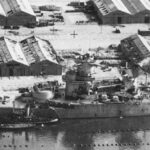
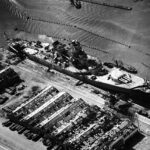
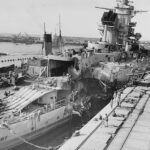
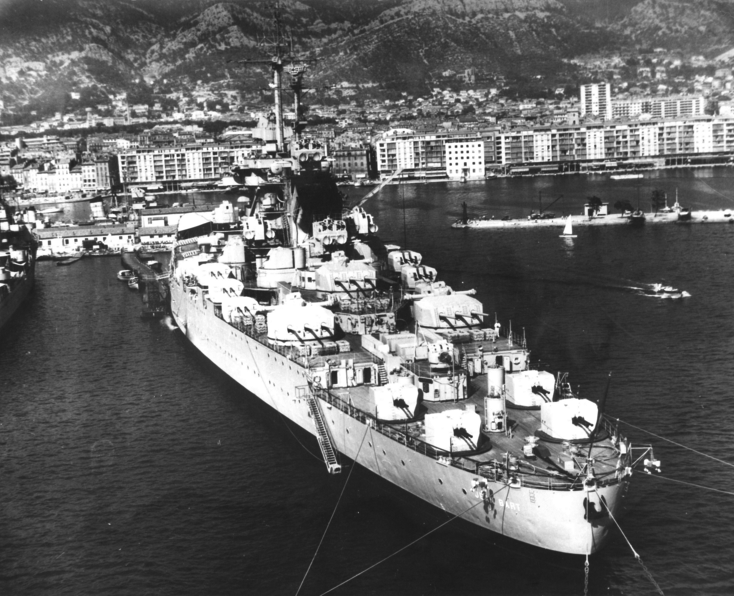
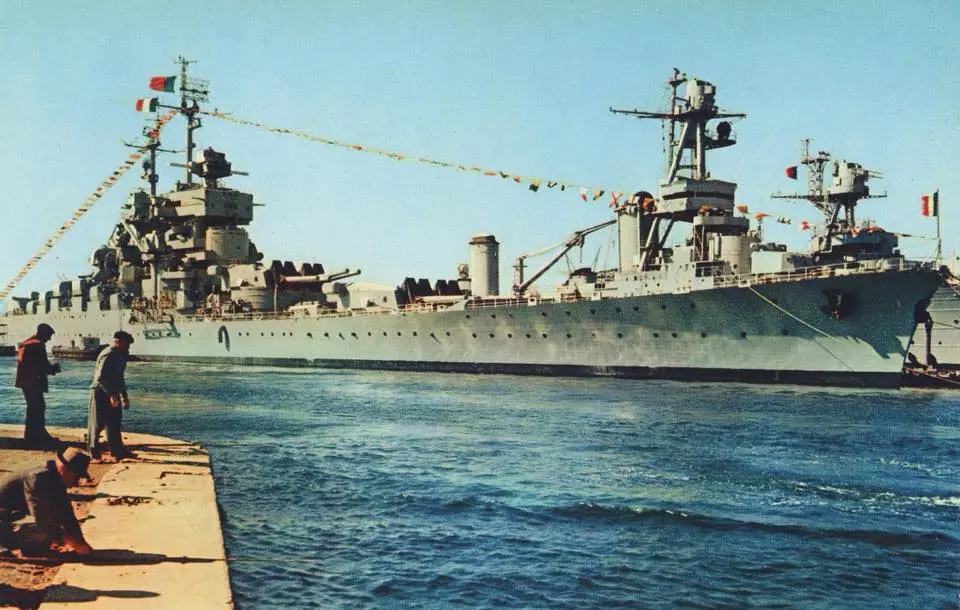
 Latest Facebook Entry -
Latest Facebook Entry -  X(Tweeter) Naval Encyclopedia's deck archive
X(Tweeter) Naval Encyclopedia's deck archive Instagram (@navalencyc)
Instagram (@navalencyc)





 Austrian Navy
Austrian Navy French Navy
French Navy Royal Navy
Royal Navy Armada Espanola
Armada Espanola K.u.K. Kriegsmarine
K.u.K. Kriegsmarine Dansk Marine
Dansk Marine Nautiko Hellenon
Nautiko Hellenon Koninklije Marine 1870
Koninklije Marine 1870 Marinha do Brasil
Marinha do Brasil Osmanlı Donanması
Osmanlı Donanması Marina Do Peru
Marina Do Peru Marinha do Portugal
Marinha do Portugal Regia Marina 1870
Regia Marina 1870 Nihhon Kaigun 1870
Nihhon Kaigun 1870 Preußische Marine 1870
Preußische Marine 1870 Russkiy Flot 1870
Russkiy Flot 1870 Svenska marinen
Svenska marinen Søværnet
Søværnet Union Navy
Union Navy Confederate Navy
Confederate Navy Armada de Argentina
Armada de Argentina Imperial Chinese Navy
Imperial Chinese Navy Marinha do Portugal
Marinha do Portugal Mexico
Mexico Kaiserliche Marine
Kaiserliche Marine 1898 US Navy
1898 US Navy Russkiy Flot
Russkiy Flot French Naval Aviation
French Naval Aviation Russian Naval Aviation
Russian Naval Aviation Sovietskiy Flot
Sovietskiy Flot Royal Canadian Navy
Royal Canadian Navy Royal Australian Navy
Royal Australian Navy RNZN Fleet
RNZN Fleet Chinese Navy 1937
Chinese Navy 1937 Kriegsmarine
Kriegsmarine Chilean Navy
Chilean Navy Danish Navy
Danish Navy Finnish Navy
Finnish Navy Hellenic Navy
Hellenic Navy Polish Navy
Polish Navy Romanian Navy
Romanian Navy Turkish Navy
Turkish Navy Royal Yugoslav Navy
Royal Yugoslav Navy Royal Thai Navy
Royal Thai Navy Minor Navies
Minor Navies Albania
Albania Austria
Austria Belgium
Belgium Columbia
Columbia Costa Rica
Costa Rica Cuba
Cuba Czechoslovakia
Czechoslovakia Dominican Republic
Dominican Republic Haiti
Haiti Hungary
Hungary Honduras
Honduras Estonia
Estonia Iceland
Iceland Eire
Eire Equador
Equador Iran
Iran Iraq
Iraq Latvia
Latvia Liberia
Liberia Lithuania
Lithuania Mandchukuo
Mandchukuo Morocco
Morocco Nicaragua
Nicaragua Persia
Persia San Salvador
San Salvador Sarawak
Sarawak Uruguay
Uruguay Venezuela
Venezuela Zanzibar
Zanzibar Warsaw Pact Navies
Warsaw Pact Navies Bulgaria
Bulgaria Hungary
Hungary

 Bundesmarine
Bundesmarine Dutch Navy
Dutch Navy Hellenic Navy
Hellenic Navy Marina Militare
Marina Militare Taiwanese Navy
Taiwanese Navy Chinese Navy
Chinese Navy Indian Navy
Indian Navy Indonesian Navy
Indonesian Navy JMSDF
JMSDF North Korean Navy
North Korean Navy Philippines Navy
Philippines Navy ROKN
ROKN IDF Navy
IDF Navy Royal New Zealand Navy
Royal New Zealand Navy Egyptian Navy
Egyptian Navy South African Navy
South African Navy

































 RN
RN
 Marine Nationale
Marine Nationale
 Soviet Navy
Soviet Navy
 dbodesign
dbodesign